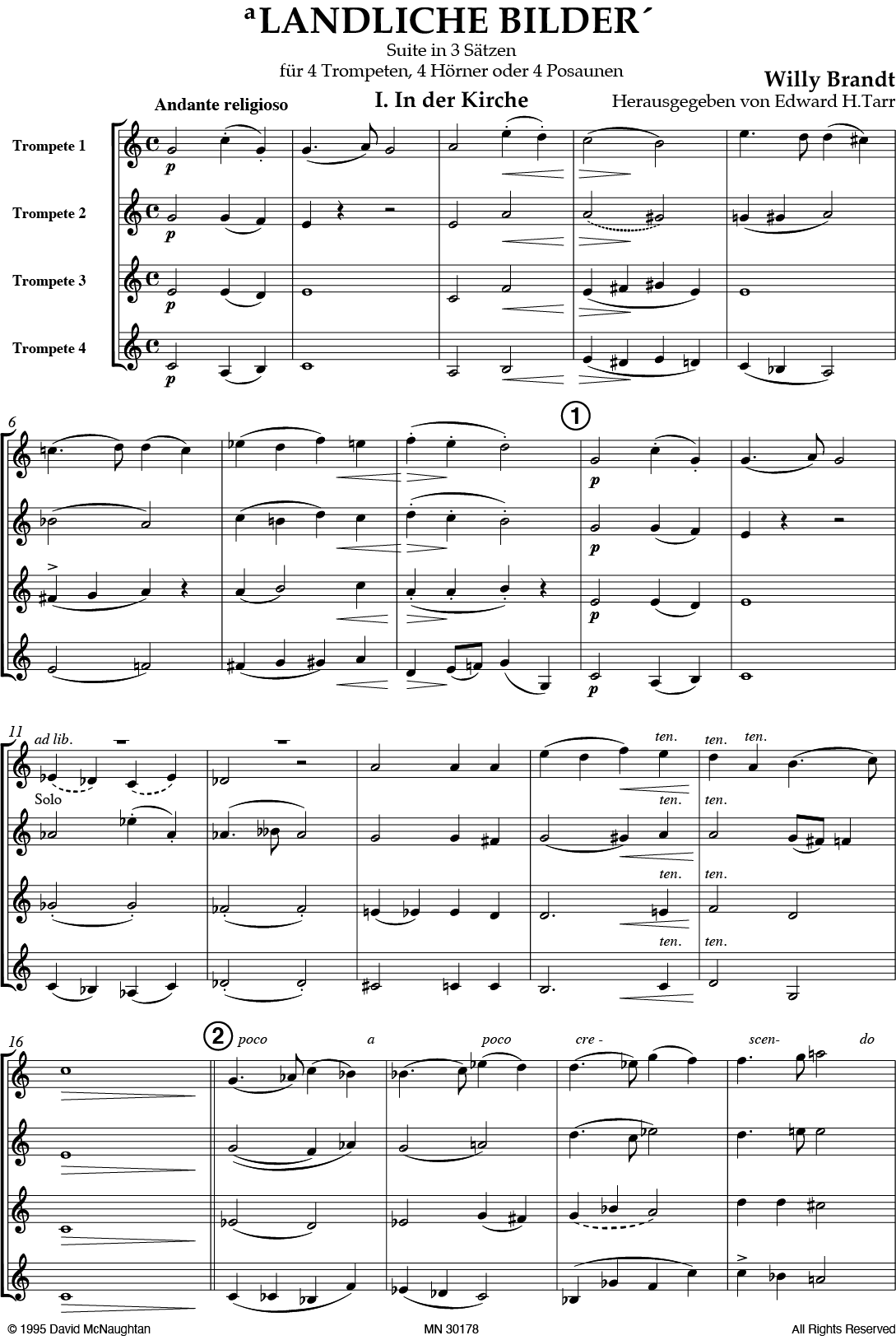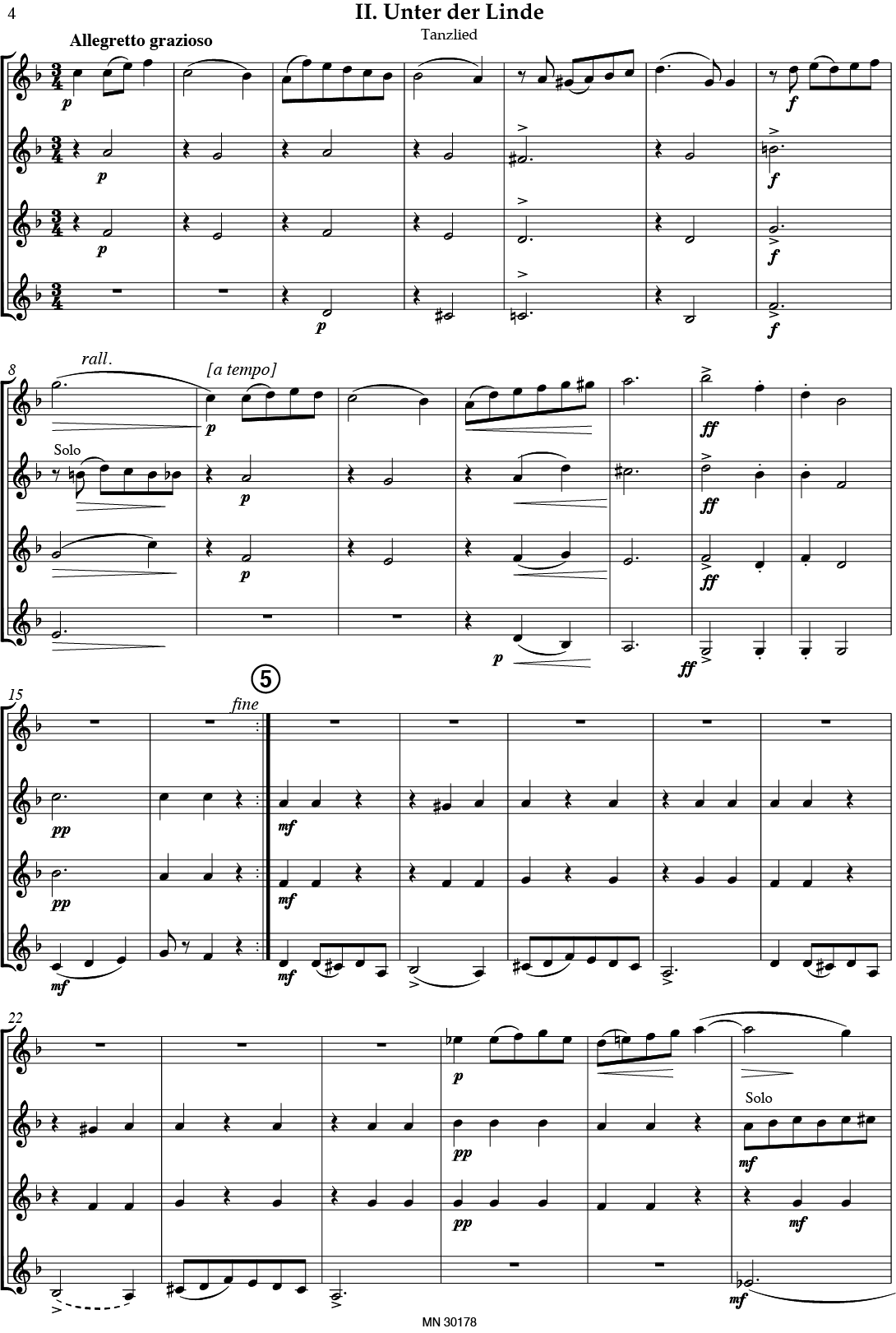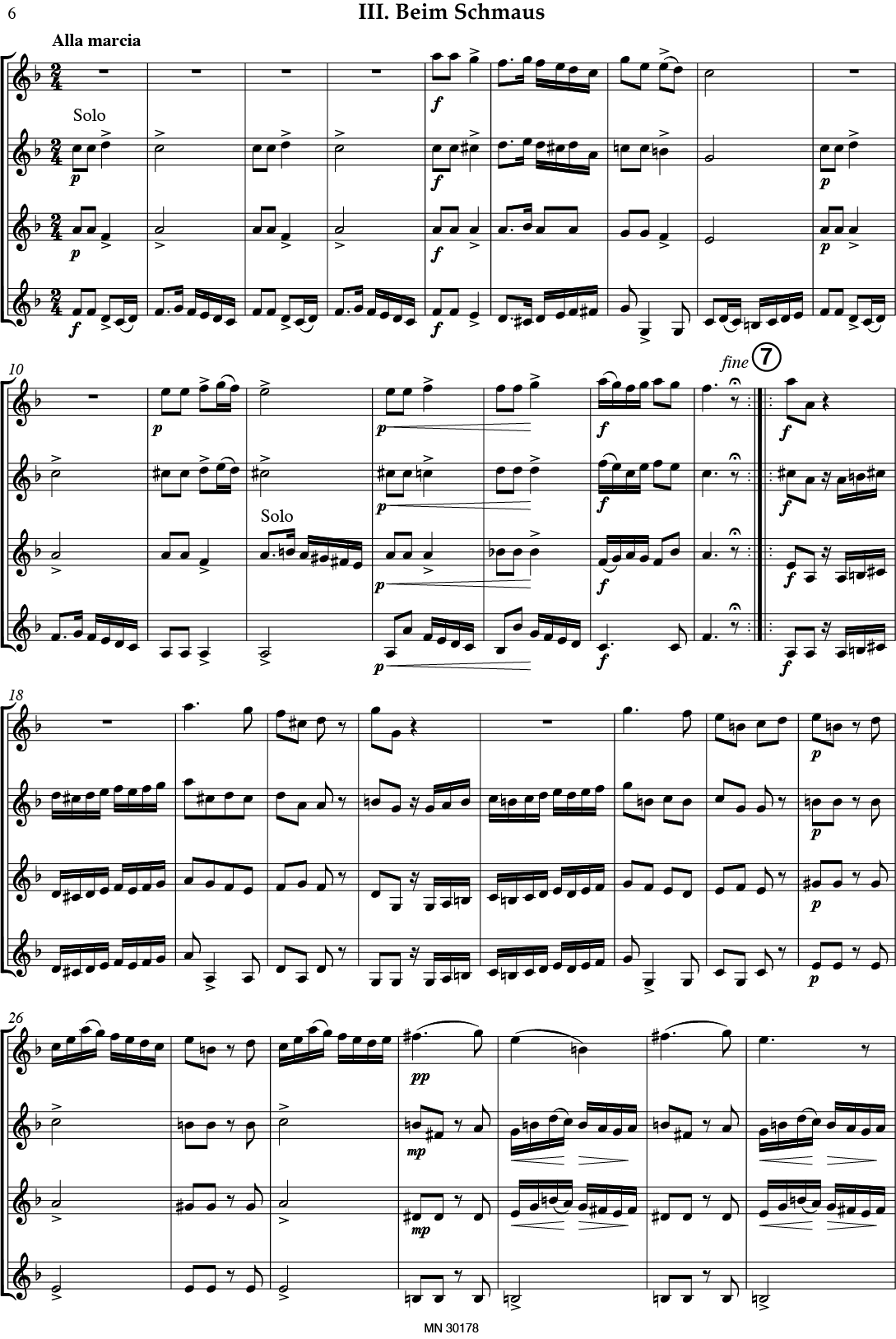
Brandt Ländliche Bilder
Brandt – Early YearsThe trumpeter, composer, and conductor Willy Brandt (1869–1923) came from Bavaria, emigrated to Moscow, and exerted a decisive influence on the Russian school of trumpet playing. He is revered even today, not only in Russia. Brandt came from Coburg. A birth certificate cannot be found, and it is assumed that he must have been born in one of the outlying villages. He is said to have studied for four years at the local music school, which was directed by the court chapelmaster Zimmermann. At the age of eighteen he was already a virtuoso. He spent at least two summer seasons (1887 and 1888) in the spa orchestra in Oeynhausen, from where he would leave at the end of September for Helsinki, where he was active in the Orchestra Society as “1st trumpeter and soloist” for the three winter seasons from 1887 to 1890. The conductor in these two places was Robert Kajanus (1856–1933), who had founded the Helsinki orchestra in 1882, was known for his performances of Beethoven, and was an early champion of Sibelius. From surviving contemporary concert programs we glean Brandt’s soloistic repertoire: J. B. Arban (1825–1889), Carneval de Venise, solo for cornet a pistons (Helsinki, 19th April 1890); Dimitresco, Doi occhi (Zwei Augen) (Oeynhausen, 16th September 1888); Fuchs, Fantasy on Webers Last Thought for trumpet (Helsinki, 20th and 27th October 1888); W. Herfurth, Concertino in E flat for trumpet or cornet (Helsinki, 2nd April 1888, 26th January 1889); Theodor Hoch (1843–1906), Nordische Fantasie for trumpet or cornet à pistons, respectively (Helsinki, 16th February and 5th March 1889).
Arrival in Moscow
In 1890, Brandt appeared at an audition for the position of 1st trumpeter in the opera orchestra of the Bolshoi Theater in Moscow – a few minutes too late. The position had already been filled. Since he came from such a great distance, he was allowed to perform for five minutes. His rendition of an Arban etude was so brilliant that the commission recognized him as a “star”. So as not to lose such an exceptional musician, they offered him a vacant contrabassoonist’s position. Soon after that he was given the coveted first trumpeter’s chair. Brandt thrived on new operas in the repertoire by Rimsky Korsakov, Tchaikovsky, Wagner, and others, and enjoyed the respect and good feelings of the orchestra and his brass playing colleagues.
Brandt’s Tone – Brandt as a Teacher
In Moscow Brandt, who had always signed as “Willy”, took on the Russified first names of Vasili Georgyevich, although in 1910 his publisher J. H. Zimmermann once again rendered his name as “Willy Brandt”. In 1899 Brandt was given a professorship at the Moscow Conservatory, as successor of the first one to occupy this position, Fiodor Richter (1826–1901) from Saxony. One of his most important pupils, Pyotr Lyamin (1884–1968), remembered later his first impression of Brandt. It was in 1905 in a concert of the Bolshoi Theater Orchestra together with the combined military bands of the Moscow garrison. “At the final concluding theme [of Tchaikovsky’s Marche slave] the combined bands of the Moscow garrison were added, and in the culmination the powerful, beautiful tones of the trumpeter Brandt sounded” above all the others. Reports of Brandt’s powerful tone can be found repeatedly.
Besides his orchestral position and his professorship, Brandt also conducted the [wind] orchestra of the Alexandrovsky Military School. A recording of his conducting the band in 1911 has survived. Among his pupils were Lyamin, who from 1909 on, still a student, was a member of the orchestra of Diaghilev’s saisons russes in Paris, thus participating in the world premiere of Stravinsky’s Le sacre du printemps; Pavel V. Klotchkov (1884–1966), who became a soloist and conductor in St. Petersburg and recorded at least 35 numbers for the phonograph between 1911 and 1914; and Vladimir Drucker (c. 1898–1974), who became first trumpet in the Los Angeles Philharmonic in 1919–23 and 1935–44. His most important pupil, however, one who also played in a brass quartet with him, was probably Mikhail Tabakov (1877–1956). Tabakov, who is regarded as the founder of the Soviet school of trumpet playing, was the teacher of Timofei A. Dokshidzer (1921–) and many others. Tabakov used to say that Awe [all] have learned from Brandt how to play.
Last Years in Saratov
In all of Russia there were until 1912 only two high level conservatories of music, those in St. Petersburg and Moscow, founded in 1862 and 1866, respectively, by the Rubinstein brothers. Only in 1912 was a third one founded in Saratov (in the Volga district). This institution was provided with first rate professors, among them Brandt. There he also led the Conservatory symphony orchestra. He died unexpectedly of an infection on February 2, 1923. Brandt was married and had a daughter, whose trace disappeared after World War II. During lessons, he liked to provide a piano accompaniment to his pupils’ etudes. He always carried his mouthpiece in his vest pocket. Like Herbert L. Clarke, he would do “dry” tonguing practice while walking in the street. He enjoyed his pupils’ loving respect. According to his testimony, an orchestral musician should always carry three objects with him: “a pencil, an eraser, and ... a corkscrew!”
Brandt’s Instruments
According to Lyamin’s testimony, Brandt played everything on a B flat trumpet made by Heckel. As a cornetist, he used a French style cornet made by J. H. Zimmermann, St. Petersburg. This instrument, which has survived as a ruin, is now on display in the Bad Säckingen Trumpet Museum.
His Compositions
Today, the following works by Brandt survive: the present Ländliche Bilder without opus no., which probably were written around 1900 or shortly thereafter; various works, Op. 11 16, which were all published in 1910, among them two Concert Pieces in F minor and E flat major for trumpet and piano which are frequently played today; and two collections of etudes without opus no., 32 Etudes and 24 Etudes (“Last”), written in Saratov.
To honour the memory of this artist musician, is publishing these pieces one by one. The series begins with the present Suite in three movements, Ländliche Bilder.
Ländliche Bilder
Under the title of Country Pictures, these three short movements have enjoyed a certain popularity for years. According to the title page of the original publication C see illustration C a performance on trumpets, horns, or trombones is possible. In the editor’s opinion they sound the best and the most “authentic” when played on cornets.
They appeared about 1906 with the well known publisher, Pyotr Ivanovich Jürgenson (1836–1904), who among other things is known for his having secured the publishing rights to the works of Tchaikovsky at extremely favourable conditions, growing immensely wealthy. “When he received from the music publisher Jürgenson an offer of 3,000 Roubles per year for the rights to everything he wrote, Tchaikovsky immediately accepted ... Jürgenson, little by little, became tremendously wealthy, while the cause of this avalanche of gold died in very modest circumstances. I do not know for how many years this unjust contract remained in force.” (The publishing house was founded in 1861. After Jürgenson’s death it was run by his two sons. In 1918 it was taken over by the state.) They must have been published in 1900 or shortly after, since that date (referring to the Paris World’s Fair) appears on the title page of the original printed edition.
A manuscript of this suite has also survived, but in our opinion it is merely a copy made later. It contains a few mistakes which are also to be found in the original print, plus a few more, and can therefore be ignored.
It is not known on what occasion these concise, pleasant pieces were first played. Perhaps Brandt wrote them for his pupils. Like most pieces for brass instruments from the turn of the century, they occupy a position somewhat in the middle between serious and light music. Editor and publisher wish performers lots of fun with them!



